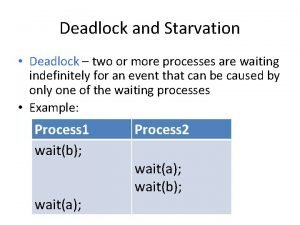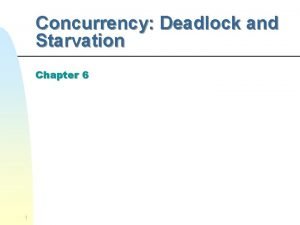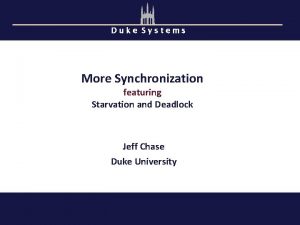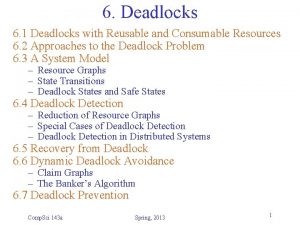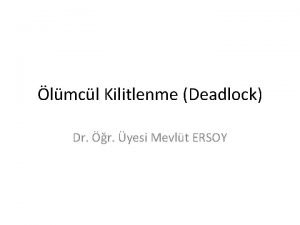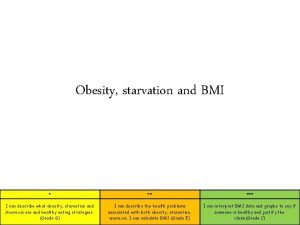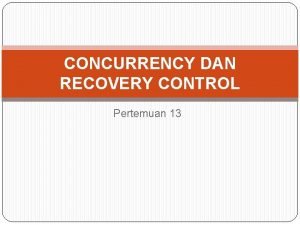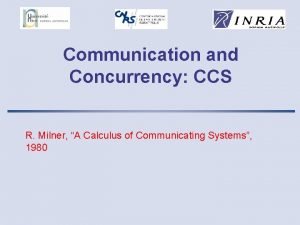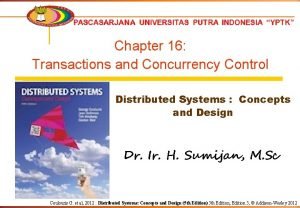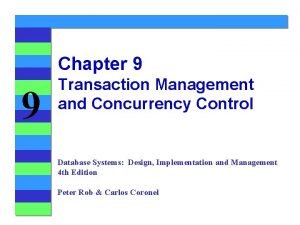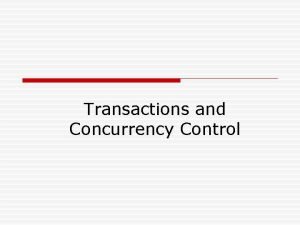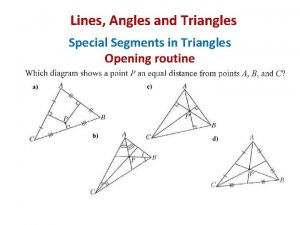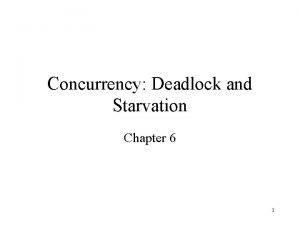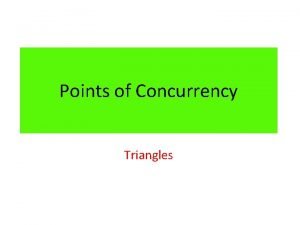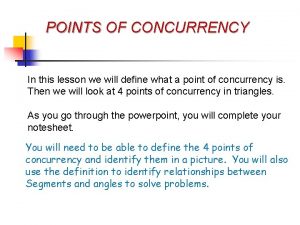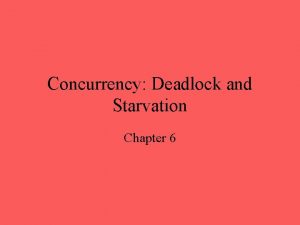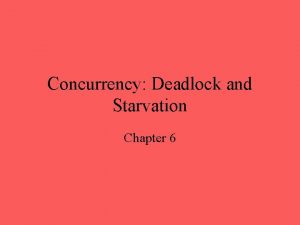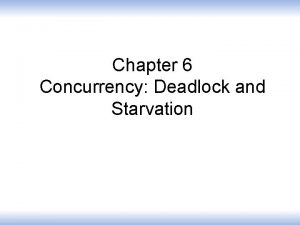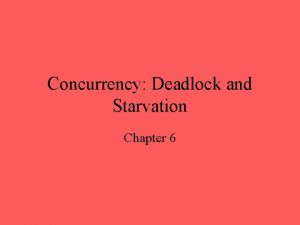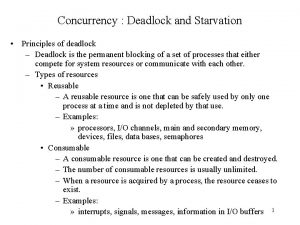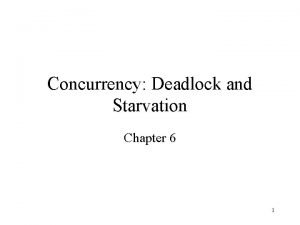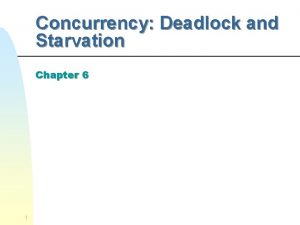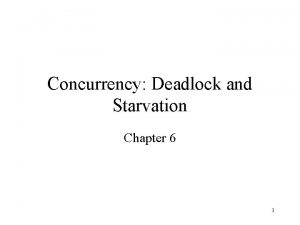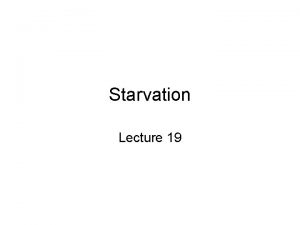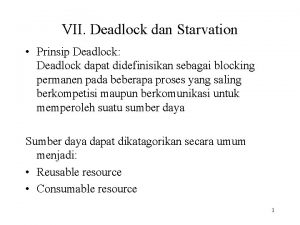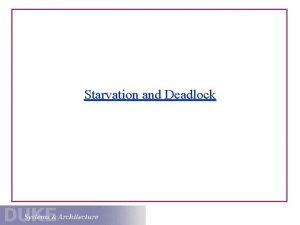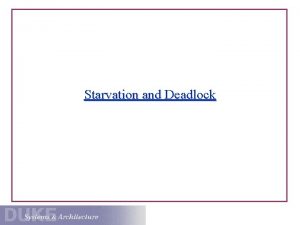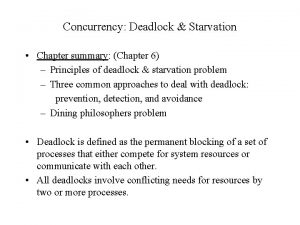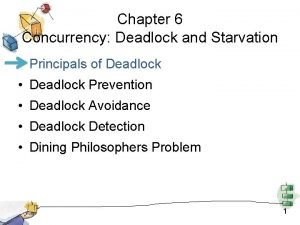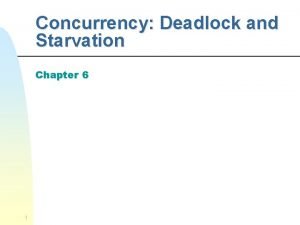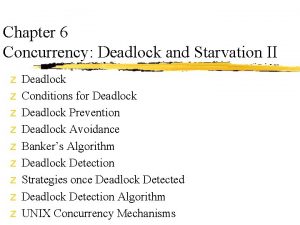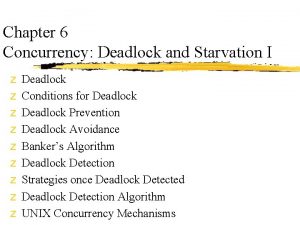Concurrency Deadlock and Starvation Chapter 6 Deadlock Permanent

























- Slides: 25

Concurrency: Deadlock and Starvation Chapter 6

Deadlock • Permanent blocking of a set of processes that either compete for system resources or communicate with each other • No efficient solution • Involve conflicting needs for resources by two or more processes




Reusable Resources • Used by one process at a time and not depleted by that use • Processes obtain resources that they later release for reuse by other processes • Processors, I/O channels, main and secondary memory, files, databases, and semaphores • Deadlock occurs if each process holds one resource and requests the other

Example of Deadlock

Another Example of Deadlock • Space is available for allocation of 200 K bytes, and the following sequence of events occur P 1 P 2 . . . Request 80 K bytes; Request 70 K bytes; Request 60 K bytes; Request 80 K bytes; . . . • Deadlock occurs if both processes progress to their second request

Consumable Resources • Created (produced) and destroyed (consumed) by a process • Interrupts, signals, messages, and information in I/O buffers • Deadlock may occur if Receive message is a blocking call • May take a rare combination of events to cause deadlock

Example of Deadlock • Deadlock occurs if receive is blocking P 1 P 2 . . . Receive(P 2); Receive(P 1); Send(P 2, M 1); Send(P 1, M 2); . . .

Conditions for Deadlock • Mutual exclusion – Only one process may use a resource at a time • Hold-and-wait – A process holds one resource while requesting another resource • No Preemption – No resource may be removed from a process by force

Conditions for Deadlock • Circular wait – A closed chain of processes exists such that each process holds resource needed by next

All Conditions • First three conditions lead to the fourth condition • All four conditions are necessary and sufficient for a deadlock to occur • Design the system to exclude the possibility of a deadlock!!

Deadlock Prevention • Indirect method calls for preventing the occurrence of first 3 conditions • Direct method calls for preventing the fourth condition • Mutual Exclusion is unavoidable • Hold and wait can be eliminated by forcing the processes to request all resources at the same time (impractical) • If a process is denied a requested resource, it should release the resource currently held • Define linear ordering of resource types so a process can only request next resource in the

Deadlock Avoidance • Prevention results in inefficient use of resources • We can use deadlock avoidance in which first three conditions still hold • A decision is made dynamically whether the current resource allocation request will, if granted, potentially lead to a deadlock • Requires knowledge of future process request

Two Approaches to Deadlock Avoidance • Do not start a process if its demands might lead to deadlock • Do not grant an incremental resource request to a process if this allocation might lead to deadlock

Process Initiation Denial • A process declares all its resource requests in advance • A process can only be started if maximum requirements of all current processes plus its own requirements can be met • It is a worst case strategy because it assumes the worst (all required resources will be needed at the same time) so it is an inefficient approach

Resource Allocation Denial • Referred to as the banker’s algorithm • State of the system is the current allocation of resources to process • Safe state is where there is at least one sequence that does not result in deadlock • Unsafe state is a state that is not safe

Determination of a Safe State Initial State

Determination of a Safe State P 2 Runs to Completion

Determination of a Safe State P 1 Runs to Completion

Determination of a Safe State P 3 Runs to Completion

Determination of an Unsafe State

Determination of an Unsafe State (Not Necessarily a Deadlocked State) P 1 requests one unit each of R 2 and R 3; results in an unsafe state if granted (R 1 request still unfulfilled for P 1, P 2, P 3, P 4)

Deadlock Avoidance Conditions • Maximum resource requirement must be stated in advance • Processes under consideration must be independent; no synchronization requirements • There must be a fixed number of resources to allocate • No process may exit while holding resources
 Deadlock and starvation
Deadlock and starvation Deadlock and starvation
Deadlock and starvation Deadlock summary by chapters
Deadlock summary by chapters Starvation vs deadlock
Starvation vs deadlock Deadlock prevention and avoidance
Deadlock prevention and avoidance Starvation vs deadlock
Starvation vs deadlock Starvation deadlock
Starvation deadlock Starvation method of extinguishing fire
Starvation method of extinguishing fire Flow starvation waveform
Flow starvation waveform A natural physical drive that prevents starvation
A natural physical drive that prevents starvation Starvation bmi
Starvation bmi Starvation diabetes mellitus
Starvation diabetes mellitus Excoriate mnemonic
Excoriate mnemonic Pessimistic concurrency control
Pessimistic concurrency control Pengertian concurrency
Pengertian concurrency Communication and concurrency
Communication and concurrency Safety and liveness in concurrency
Safety and liveness in concurrency Transactions and concurrency control in distributed systems
Transactions and concurrency control in distributed systems Binary lock in dbms example
Binary lock in dbms example Concurrency control in dbms
Concurrency control in dbms Special segments and points of concurrency
Special segments and points of concurrency Transaction management and concurrency control
Transaction management and concurrency control Deadlock chapter 37
Deadlock chapter 37 Name the point of concurrency of the angle bisectors
Name the point of concurrency of the angle bisectors Circumcenter practice problems
Circumcenter practice problems Concurrency in web applications
Concurrency in web applications
